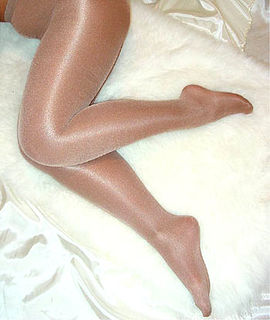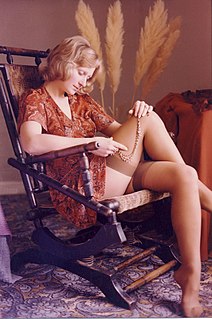Related Research Articles

Lingerie is a category of primarily women's clothing including undergarments, sleepwear, and lightweight robes. The choice of the word is often motivated by an intention to imply that the garments are alluring, fashionable or both. In a 2015 US survey, 75% of women and 26% of men reported having worn sexy lingerie in their lifetime.

Tights are a kind of cloth garment, most often sheathing the body from the waist to the toe tips with a tight fit, hence the name. They come in absolute opaque, opaque, sheer and fishnet styles — or a combination, such as the original concept of the American term pantyhose with sheer legs and opaque panty.

Pantyhose, called sheer tights, or tights in the United Kingdom and a few other countries, are close-fitting legwear covering the wearer's body from the waist to the toes. Mostly considered to be a garment for women and girls, pantyhose first appeared on store shelves in 1959 as a convenient alternative to stockings and/or control panties.

The Wonderbra is a type of push-up underwire brassiere that gained worldwide prominence in the 1990s. Although the Wonderbra name was first trademarked in the U.S. in 1955, the brand was developed in Canada. Moses (Moe) Nadler, founder and majority owner of the Canadian Lady Corset Company, licensed the trademark for the Canadian market in 1939. By the 1960s the Canadian Lady brand had become known in Canada as "Wonderbra, the company." In 1961 the company introduced the Model 1300 plunge push-up bra. This bra became one of the best-selling Canadian styles and is virtually identical to today's Wonderbra.
Spanx, Inc. is an American underwear maker focusing on shaping briefs and leggings, founded in Atlanta, Georgia. The company manufactures mainly pantyhose and other underwear for women and, since 2010, produces male underwear as well. Spanx specializes in foundation garments intended to make people appear thinner.

Playtex is an American brand name for undergarments, baby products, gloves, feminine products, and sunscreen. The brand began in 1947 when International Latex Corporation (ILC) created a division named Playtex to produce and sell latex products. Playtex was the first to advertise undergarments on national television in 1955, written by Howard Shavelson at Olgilvie and Mather, and the first to show a woman wearing only a bra from the waist-up in a commercial in 1977. They developed space suits for the Apollo program.

Jockey International, Inc. is an American manufacturer, and retailer of underwear, sleepwear and sportswear for men, women, and children. The company is based in Kenosha, Wisconsin. Jockey is known for having invented the first men's Y-Front brief in 1934. Jockey is a recognized trademark in 120 countries.

In sewing, a gusset is a triangular or rhomboidal piece of fabric inserted into a seam to add breadth or reduce stress from tight-fitting clothing. Gussets were used at the shoulders, underarms, and hems of traditional shirts and chemises made of rectangular lengths of linen to shape the garments to the body.

Hanes and Hanes Her Way is a brand of clothing.
In American English, the term pantyhose generally refers to hosiery traditionally worn by women since their introduction in 1959, however some manufacturers also produce pantyhose for men, or, colloquially, mantyhose, brosiery, or guylons.
Hanesbrands Inc. is an American multinational clothing company based in Winston-Salem, North Carolina. It employs 65,300 people internationally. On September 6, 2006, the company and several brands were spun off by the Sara Lee Corporation.

L'eggs is a brand of pantyhose, introduced in 1969 by Hanes, which radically changed the hosiery marketplace. The novel developments were the egg-shaped plastic product container, the shift to consignment sales in drug stores and groceries, and the in-store product racks designed to emphasize the egg shape. The brand logo hinted at a pair of chicks or eggs in the lettering.

Funpals are a children's underwear name brand that was established in 1985 in order to compete with Underoos. Its trademark was renewed on March 17, 2005 by Mr. William R. Hansen, trademark correspondent.

Undergarments or underwear are items of clothing worn beneath outer clothes, usually in direct contact with the skin, although they may comprise more than a single layer. They serve to keep outer garments from being soiled or damaged by bodily excretions, to lessen the friction of outerwear against the skin, to shape the body, and to provide concealment or support for parts of it. In cold weather, long underwear is sometimes worn to provide additional warmth. Special types of undergarments have religious significance. Some items of clothing are designed as undergarments, while others, such as T-shirts and certain types of shorts, are appropriate both as undergarments and as outer clothing. If made of suitable material or textile, some undergarments can serve as nightwear or swimsuits, and some are intended for sexual attraction or visual appeal.
Showtoons were a trademark of unisex children's underwear that were manufactured by Hanes, established in 1989, and disestablished in 2009. Its competitor, Fruit of the Loom, manufactured the gender-specific Funpals and FunGals brands. The reasoning behind the brand segregation is for marketing purposes.

Underwear fetishism is a sexual fetishism relating to undergarments, and refers to preoccupation with the sexual excitement of certain types of underwear, including panties, stockings, pantyhose, bras, or other items. Some people can experience sexual excitement from wearing, while others get their excitement when observing, handling, or smelling the underwear worn by another, or watching somebody putting underwear on or taking it off.
Kayser-Roth Corporation is an underwear and hosiery manufacturer based in Greensboro, North Carolina. The company currently markets three owned brands in North America, No Nonsense, Hue and Burlington.

A girdle is a form-fitting foundation garment that encircles the lower torso, extending below the hips, and worn often to shape or for support. It may be worn for aesthetic or medical reasons. In sports or medical treatment, a girdle may be worn as a compression garment. This form of women's foundation replaced the corset in popularity, and was in turn to a larger extent surpassed by pantyhose in the 1960s.
Petit Bateau is a French brand of clothing and underwear for children founded in 1920, but whose origins date back to 1893, in Troyes. Integrated into the Rocher Group since 1988, Petit Bateau is a children's brand that became trans-generational in the 2000s thanks to the launch of the adult collection.
Depend is a brand of absorbent, disposable underwear and undergarments for people with urinary or fecal incontinence. It is a Kimberly-Clark brand, and positions its products as an alternative to typical adult diapers. Depend is the dominant brand of disposable incontinence garments in the United States with a 49.4 share of the market.